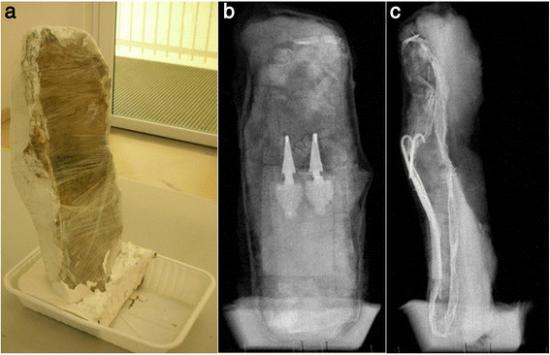Source -
http://7thspace.com/headlines/503380/x_ray_tomography_of_a_soil_block_a_useful_tool_for_the_restoration_of_archaeological_finds.html

The soil block. The appearance of the soil block as arrived at the restoration laboratory after its extraction in the archaeological excavation. Re et al. Heritage Science 2015 3:4 doi:10.1186/s40494-015-0033-6
IntroductionX-ray imaging is a very powerful tool which can be exploited in several fields. In the last few years, its use in archaeology has grown consistently.
One of the most recent and interesting applications of computed X-ray tomography (CT) is the analysis of soil blocks, coming from excavations, in order to seek for finds of different kinds and materials possibly contained therein. For this purpose, both medical and industrial CT scanners have been employed.
In this paper, the application of a CT instrument specifically designed and developed for the analysis of Cultural Heritage materials is presented. We analysed a soil block extracted from a necropolis in the Italian region of Abruzzo and probably dating back to the VI-IV century B.C ., which was found to contain a bronze belt.
Results: Thanks to the versatility of the CT equipment we designed, a complete scan has been obtained in less than four hours and has delivered extremely useful information in a completely non-invasive way.
The CT dataset and images allowed a virtual extraction of the find to be performed before the actual stratigraphic recovery that, in this case, was simplified thanks to the merging of the archaeological evidences and with information coming from scientific analyses. The information provided by the tomography consisted in: the distribution, shape and dimensions of fragments composing the artefact; indications about its general conditions; the recognition of repairs done in the past and the presence of different materials (although not precisely identified).
Conclusions: The use of CT has great potential for the work of both archaeologists and restorers.
The indirect extraction of an artefact from an archaeological excavation, which entailed moving a soil block to the laboratory, allowed one to reconstruct almost all its parts and to collect information about materials. CT analysis has been particularly useful for determining both its conditions and its repairs before the actual recovery, thereby facilitating the restoration process.The recovery and conservation of an historical piece like the one presented here can help archaeological and conservation studies, enrich a museum collection and contribute to the dissemination of acquired cultural information.Graphical AbstractX-ray imaging of a soil block from an archaeological excavation and the extracted metal belt.
Author: Alessandro Re Jacopo Corsi Marco DemmelbauerMargherita MartiniGiorgia MilaChiara Ricci
Credits/Source: Heritage Science 2015, 3:4

CT 3D rendering. 3D rendering of the CT volume of the soil block: (a) complete volume; (b)transparency effect of the earth; (c) segmentation of the metallic parts inside the soil block. Re et al. Heritage Science 2015 3:4 doi:10.1186/s40494-015-0033-6